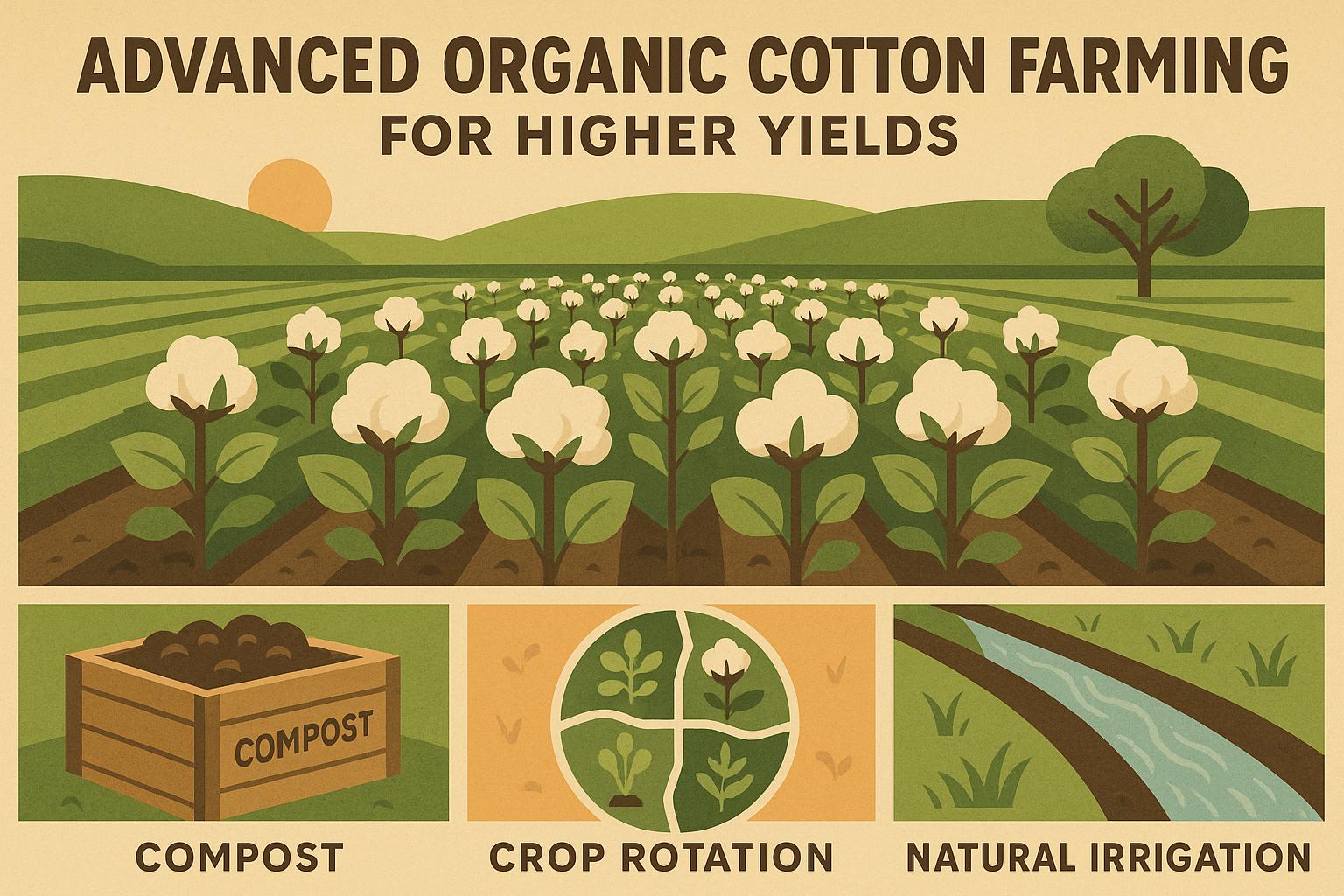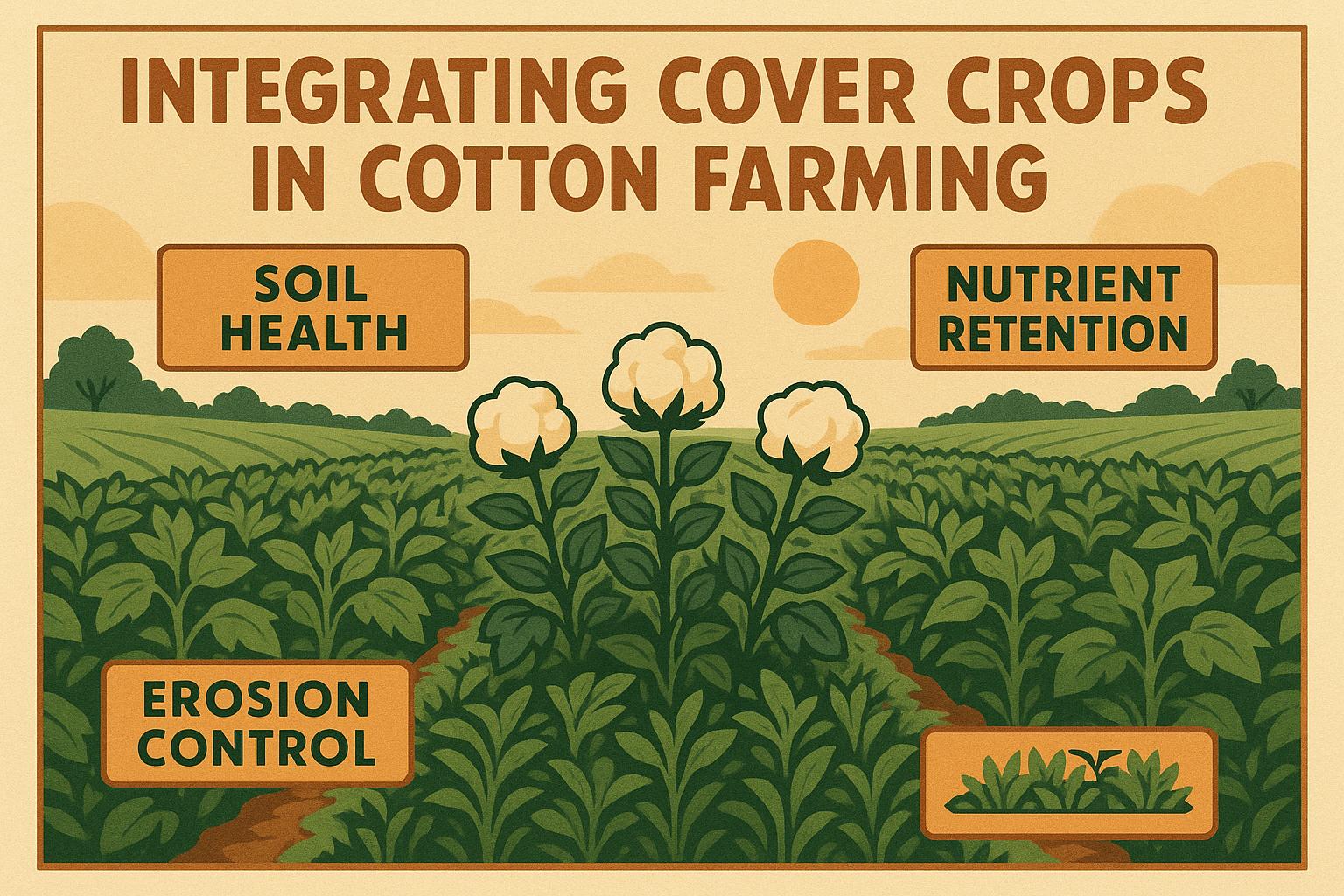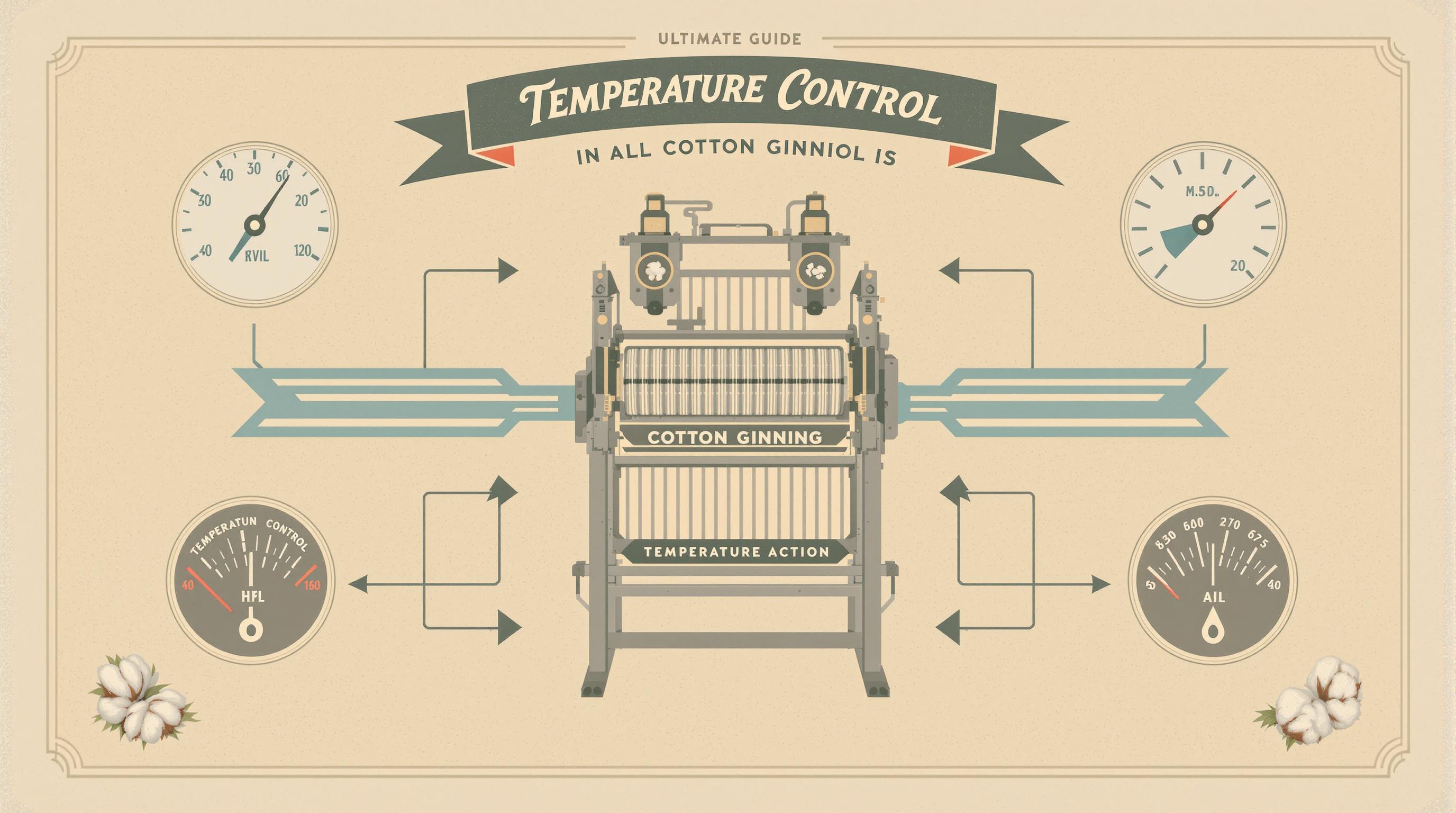Federal cotton insurance helps U.S. cotton farmers manage risks like unpredictable weather and market changes. Here’s what you need to know:
- What It Covers: Drought, excess moisture, hail, wind, freezes, and disease.
- Coverage Levels: Farmers can choose from basic catastrophic (CAT) coverage to advanced options like Yield Protection (YP) and Revenue Protection (RP).
- Government Support: 60% of premiums are subsidized, making coverage more affordable.
- Key Stats: In 2022, average coverage levels hit 75%, with drought and excess moisture accounting for nearly 70% of claims.
Quick Tip: Work with an insurance agent to select the right plan based on your farm’s size, location, and financial goals. Keep reading to learn how coverage levels are set, plan options, and tips for maximizing your protection.
Crop Insurance 101
How Coverage Levels Are Set
Federal cotton insurance coverage levels are determined by analyzing two main factors: historical production data and local price standards. This structured approach ensures coverage levels are based on both past yield performance and county-specific price benchmarks.
Production History and Yield Data
The starting point for calculating coverage levels is a farmer's Actual Production History (APH), which averages yield records from 4 to 10 consecutive years. For farmers with incomplete records, the USDA uses transition yields, or T-yields, to fill the gaps. The percentage of the county T-yield assigned depends on how many years of data are available:
| Years of Available Records | Assigned Yield Percentage |
|---|---|
| No records | 65% of county T-yield |
| 1 year | 70% of county T-yield |
| 2–4 years | 75% of county T-yield |
| 4+ years | 80% of county T-yield |
The approved yield, a combination of the farmer’s APH and the chosen coverage level, serves as the foundation for calculating both liability and premiums. This figure is key for Yield Protection (YP) policies and revenue protection decisions.
County Price Standards
County price standards are another critical factor, particularly for revenue protection plans. The Risk Management Agency (RMA) sets these standards by analyzing projected and harvest prices. These prices directly influence the guaranteed revenue offered to cotton farmers. Revenue Protection (RP) plans use these price benchmarks to help farmers guard against losses caused by low yields or falling prices.
Coverage Level Options
This section dives into the specific coverage options available for cotton farmers, ranging from basic catastrophic protection to more advanced, revenue-focused plans. These options allow farmers to align their risk management strategies with their financial goals.
Basic CAT Coverage
Catastrophic Risk Protection (CAT) offers a baseline level of coverage for cotton farmers. It compensates for crop yield losses that exceed 50% of the farmer's average historical yield. Payments under this policy are calculated at 55% of the projected season's average market price. While there’s no premium to pay, farmers are required to pay a $655 administrative fee per crop, per county.
Here’s what CAT coverage includes:
- Coverage activates when yield losses exceed 50%.
- Payments apply only to losses beyond the 50% threshold.
- No premium cost, but a $655 administrative fee is mandatory.
- Farmers must adhere to USDA-defined good farming practices.
- Administrative fees are fixed, with no discounts available.
For those seeking broader protection, additional coverage plans are available.
Additional Coverage Plans
Farmers can opt for higher-level plans, which come with premium subsidies that vary based on the chosen coverage level and unit type.
| Coverage Type | Key Features | Premium Subsidy |
|---|---|---|
| Yield Protection (YP) | Covers yield losses only | 48–67% (depending on coverage level) |
| Revenue Protection (RP) | Covers losses from both yield reductions and price declines | 48–67% (depending on coverage level) |
| Revenue Protection with Harvest Price Exclusion (RP-HPE) | Uses only the projected price to calculate protection | 48–67% (depending on coverage level) |
"Risk management products available to producers through the federal crop insurance program are unsurpassed and provide farmers a tremendous level of flexibility to fashion risk management portfolios that meet the unique needs of their operation." – Shawn Wade, Plains Cotton Cooperative Association
Farmers looking for even more tailored options can consider supplemental plans:
- Supplemental Coverage Option (SCO): Kicks in when county average revenue drops below 86% of the expected level, with a 65% premium subsidy.
- Enhanced Coverage Option (ECO): Provides area-based protection with trigger levels set at 90% or 95%.
- Stacked Income Protection (STAX): Adds up to 20% more revenue coverage for upland cotton, supported by an 80% federal subsidy.
- Hurricane Insurance Protection (HIP-WI): Covers part of the deductible in counties affected by hurricane-force winds.
These plans offer flexibility, with subsidies determined by coverage level and unit type. For example, enterprise units can qualify for subsidies ranging from 53% to 80%, depending on the selected coverage level.
Selecting Your Coverage Level
Choosing the right coverage level for your cotton operation isn't just about picking a number - it’s about balancing financial protection with cost. Below, we break down the key factors and steps to help guide your decision-making process.
Key Decision Points
When deciding on coverage levels, keep these factors in mind:
Revenue Guarantees vs. Premium Costs
Higher coverage levels provide stronger financial protection, but they also come with higher premiums. Interestingly, about 90% of farmers stick with the same coverage levels year after year, even though this approach might not always strike the best balance between cost and protection.
Regional Differences
Where you farm matters. For example, farmers in Iowa tend to select coverage levels of 80–85%, while those in Kansas often go with 70–75%. Understanding your region’s production risks and insurance costs is crucial for making an informed choice.
Impact of Farm Size
The size of your operation also plays a role. Smaller farms - those with annual sales under $250,000 - often lean toward lower coverage levels. Larger farms, on the other hand, typically opt for more robust coverage to protect against higher exposure.
Working with Insurance Agents
Navigating crop insurance can feel overwhelming, especially with around 2,700 coverage combinations available. Farmers collectively spend about $6.5 billion annually on premiums. That’s where insurance agents come in - they can simplify the process and help you make informed decisions.
Steps for Collaborating with Your Agent
-
Initial Consultation
Begin by discussing your operation’s specific needs. Your agent will help align your coverage strategy with your risk profile. -
Risk Assessment
Work together to evaluate your production history, financial goals, risk tolerance, market trends, and local weather patterns. -
Coverage Customization
Your agent can tailor your coverage by comparing premium costs, subsidy rates, endorsements, and unit structures to find the best fit for your operation.
These steps ensure that your coverage level offers the protection you need without unnecessary costs.
Tips for Staying on Track with Your Agent
Good communication with your agent is essential. Here’s a quick reference for staying organized:
| Action Item | Purpose | Timing |
|---|---|---|
| Operation Updates | Notify of practice changes | As changes occur |
| Record Keeping | Maintain production records | Throughout the season |
| Entity Changes | Report business structure updates | Immediately |
| Claim Reporting | Report crop damage | At the first sign |
sbb-itb-0e617ca
Help and Information Sources
Federal cotton insurance can feel overwhelming, but there are trusted resources available to help farmers make informed decisions about their coverage.
Government Programs Guide
The USDA's Risk Management Agency (RMA) serves as the go-to resource for federal crop insurance. Their online tools provide:
- Real-time data on projected prices and volatility factors for insurance options.
Key Program Insights
The Federal Crop Insurance Program (FCIP) plays a significant role in protecting farmers. Here’s a quick look at its scope:
| Program Aspect | Coverage Statistics |
|---|---|
| Total Commodities | 134 unique crops |
| Annual Coverage | 293 million acres |
| Participation Rate | 81% of eligible acres |
| Average Premium Cost | 40% paid by producers |
"As of 2022, the aggregate crop coverage level reached an all-time high of 75 percent."
Where to Get Help
- Local RMA offices are available to provide tailored advice.
- The RMA website includes a directory of crop insurance agents.
These resources ensure farmers can access accurate, up-to-date guidance for their insurance needs.
Cotton Gin Directory Support
Cotton gins often act as a bridge to local expertise and resources. By visiting cottongins.org, farmers can:
- Locate nearby cotton gins across counties and states.
- Connect with regional experts for insurance advice.
- Explore local sponsorship and networking opportunities.
In addition, organizations like Cotton Incorporated publish materials to help clarify complex insurance topics.
For personalized assistance, farmers can find authorized crop insurance agents through USDA service centers or the RMA website. These agents can provide:
- Tailored recommendations for coverage.
- Detailed price quotes for insurance policies.
- Step-by-step guidance on eligibility and applications.
Whether through government programs, cotton gins, or industry publications, farmers have access to a wealth of resources to make confident insurance decisions.
Summary of Coverage Levels
Federal cotton insurance offers customized protection options like Yield Protection and Revenue Protection, designed to address the unique risks faced in cotton farming.
Here’s a quick look at key coverage options and their performance metrics from recent years:
| Coverage Type | Protection Level | Recent Performance (2015–2022) |
|---|---|---|
| Basic CAT | Minimum Coverage | Provides essential protection against catastrophic losses |
| STAX‐RP 90% | 70–90% | Delivered an average net benefit of $37.47 per acre |
| ECO | 90–95% | Extends coverage beyond basic policies |
These figures highlight the balancing act between managing risks and controlling costs - a central consideration in federal cotton insurance.
From 2015 to 2022, STAX triggered payments in 59% of cases. Farmers paid an average of $9.50 per acre for STAX‐RP 90%, while premium subsidies averaged $38.48 per acre during the same period. Weather-related risks played a significant role in payouts, with drought and high temperatures responsible for 43.7% of total indemnity payments, and excess moisture contributing 25.6%.
"Crop insurance can provide an effective means of managing risk in cotton production." – Mississippi State University Extension Service
Nearly 90% of farmers stick with consistent coverage levels year after year. However, experts recommend reevaluating coverage during periods of market volatility or when profits are at break-even levels. For added flexibility, the Enhanced Coverage Option (ECO) offers protection at 90% or 95% trigger levels, providing additional area-based coverage to complement standard policies.
FAQs
How can I choose the best crop insurance coverage level for my cotton farm based on my financial goals and local risks?
Choosing the right crop insurance coverage for your cotton farm boils down to your financial goals and the risks specific to your area. Coverage levels typically range from 50% to 85%, but many cotton farmers lean toward 70% to 80%, depending on their comfort with risk and budget considerations.
To get started, take a close look at your farm’s Actual Production History (APH). Then, factor in local challenges like drought, pest infestations, or other regional risks. If you prefer to minimize potential financial losses, opting for higher coverage might be the way to go. However, if you're willing to take on a bit more risk to save on premiums, a lower coverage level could suit you better.
For tailored recommendations, it’s a good idea to connect with a crop insurance agent. They can help you evaluate your farm’s specific risks and financial objectives, guiding you toward the best decision for your operation.
What are the pros and cons of choosing advanced coverage options like Revenue Protection compared to basic CAT coverage?
Farmers looking for more robust protection might consider Revenue Protection (RP), which offers benefits beyond the basic Catastrophic (CAT) coverage. RP shields against revenue losses caused by both low yields and market price swings, providing a safeguard for unpredictable farming conditions. It also offers flexibility, allowing farmers to choose coverage levels between 50% and 85% of their expected revenue, tailoring the plan to their specific risk tolerance.
That said, RP comes with higher premiums, making it a more significant financial commitment. On the other hand, CAT coverage is a budget-friendly option, designed to offer minimal protection. It only covers losses exceeding 50% of expected yields, which could leave farmers more exposed to financial challenges. Deciding between these options means carefully balancing the need for protection with available resources and individual circumstances.
How do Actual Production History (APH) and county price standards impact the cost and payouts of federal cotton insurance?
Actual Production History (APH) and County Price Standards in Cotton Insurance
Two critical factors in federal cotton insurance are Actual Production History (APH) and county price standards, as they directly influence both premium costs and payout amounts.
APH reflects a farmer’s historical cotton yield and serves as a measure of risk. Farmers with a higher APH - indicating consistent and robust yields - tend to pay lower premiums since they present less risk to insurers. Conversely, a lower APH, which signals higher risk, usually results in higher premiums.
Meanwhile, county price standards are tied to local market conditions and impact indemnity payments. When a loss occurs, higher county price standards can lead to larger payouts, offering better financial support. Together, these two factors work to ensure that premiums are aligned with risk levels and that payouts correspond to current market values, providing cotton farmers with coverage tailored to their unique circumstances.


